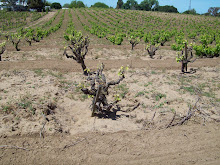
That’s a word that gets bandied about with alarming frequency. Used to sell everything from real estate to oldee tymee pharmaceuticals, “heritage” seems designed to evoke a continuous, cherished, burnished passing of the proverbial baton through the generational ages.
“Heritage” often gets comingled with the definition for “history,” and when it comes to wine, the two seemingly synonymous words might generate some confusion. The best that I can do right now, in our newly adopted 11-year-old city of Oakley, is to discern that, while Oakley has a history, the remaining grape growers tending the “historical” old vines in the ‘hood have a heritage.
Oakley has been a municipality for just over a decade, but was settled as a town well over a century ago. Portuguese and Italian immigrants to the area established a bit of the Old Country here, planting the joint to wine grapes, fruit orchards, almonds, pistachios and anything else that might take root in the sandy soil a mere fog’s drift from the San Joaquin River. As mentioned in an earlier post, it was a railhead, perfect for shipping produce (especially coveted varietal wine grapes) back east to big-city compatriots for their home winemaking.
I know that the Cline family name has not exactly been missing from this blog, but, see, that’s where the whole “heritage” vibe makes a great, big, splashy and much-deserved entrance. When Fred Cline was growing up in Southern Cali, he’d spend summers with grandpa Valeriano Jacuzzi (yep), learning at the old man’s T-vine about Oakley ag in general, and how to make wine from the Old World varietal plantings in particular. Fred founded Cline Cellars in 1982, and although he moved from Oakley to build a new, modern winery up in Sonoma, the Cline commitment to Oakley fruit is unwavering. Extensive land holdings include Big Break, Bridgehead and Live Oak vineyards, named for Oakley streets (though I suspect that the streets in an 11-year-old city might have been deferential to the erstwhile Cline presence).
Kath and I have tasted and posted about assorted vintages of these vineyard designates. But when Kathy discovered a bottle of the Cline “Heritage” Zinfandel, blended from fruit from the three Oakley food groups, we had to do the do. Live Oak, Bridgehead and Big Break are plots just two miles from each other, and these three vineyard parcels have been Cline family mainstays for decades. The 2007 Cline Heritage Zinfandel is one of the final Cline bottles in our stash, and unfortunately this prize was corked; the aroma of damp cardboard was the first thing to greet us. The corkiness burned off somewhat with time in the glass, and what remained wasn’t enough to overpower the obvious well-knit structure and hefty flavors. It’s a deep, dark monster to the eye, almost reminiscent of a Petite. Despite the unfortunate initial aroma of this particular bottle, the wine exhibits an obvious elegance lurking in the nose, with notes of currant and other concentrated dried fruit. On the tongue, there’s an otherworldly viscosity and rich unctuousness enveloping flavors of tar and oak. Tellingly, the finish on the 2007 Cline Heritage seems virtually never-ending; it goes on and on. Almost like the winemaking heritage of the Cline family itself.

No comments:
Post a Comment